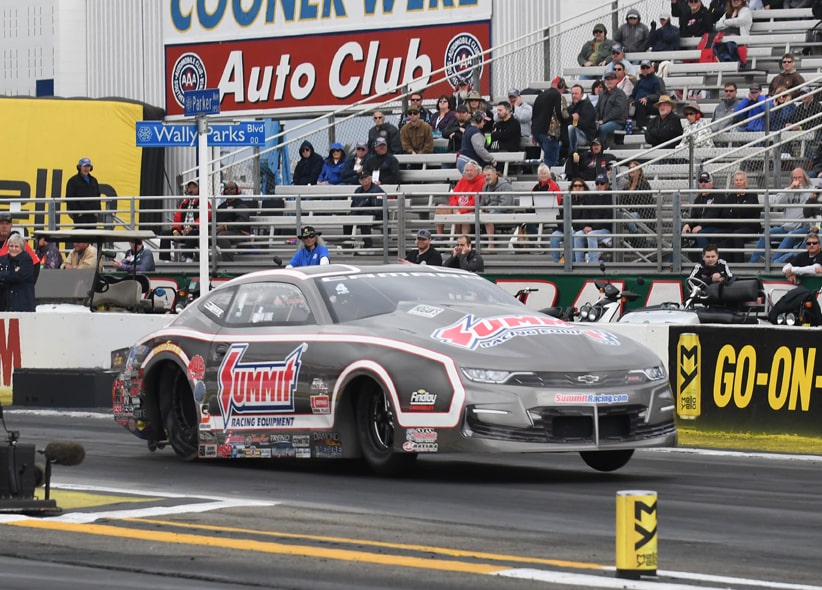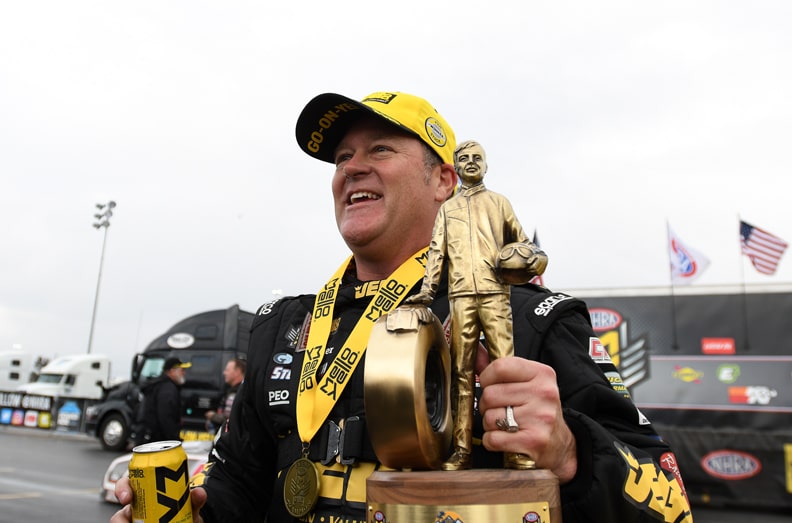

Leading into the NHRA class’ 50th anniversary year, there have been many to claim Pro Stock is on its last legs, a theory brought to light with the change from carburetors to electronic fuel injection, differing bodies and waning manufacturer competition. While there are a few Dodge and Ford Pro Stock cars being used in competition these days, they are far outnumbered by the Chevrolet Camaro club, which has garnered all championships since Allen Johnson’s 2012 title year with Dodge’s Mopar performance division.
Yeah, I’ve been one of those to lament the lower entry lists, the dearth of alternative manufacturer competition for Chevy and the mass exodus of fans from their seats when the door slammers come to the water box to compete. To my mind, Pro Stock has always been the more technical class of NHRA, since it relies on small performance gains to up the competition level.
There have been years when one team has had power over the others; certainly Gray Motorsports’ engine program with Chevrolet two years ago overpowered the regular winners like Summit Racing/KB Racing and Elite Motorsports. The latter group had a year away from Chevy during the changeover from carbs to EFI that flummoxed them and required several years spent learning the intricacies of racing an EFI-powered Camaro.
Elite now stands atop the Pro Stock pyramid, with reigning three-time champion Erica Enders and her red Melling-sponsored Camaro. Her teammate Jeg Coughlin Jr. is the current points leader after earning Pro Stock class victory in the season-opening 60th annual Lucas Oil Winternationals. It was Coughlin’s second straight victory and Elite’s third-consecutive, if you count back to Las Vegas in the fall, when Enders became the sport’s 150th female victor.
The field at Auto Club Raceway in Pomona, Calif. last weekend featured 20 entries, including a pair of Ford Mustangs and two Dodge Dart racecars. Both the Mustangs – for second generation drivers Cristian Cuadra and his brother Fernando Cuadra Jr. – made the 16-car/driver elimination field; Alan Prusiensky and Tom Huggins failed to make the field, as did last year’s season finale runner-up, Fernando Cuadra, along with newcomer Marty Robertson.
The class is exceptionally competitive and there are new faces on the horizon, including third-generation racer Mason McGaha, 18, son of Chris McGaha. Mason is expected to make his Chevy Camaro debut in Gainesville this March, the third of 18 Pro Stock competitions on the schedule. While McGaha’s operation is an individual one, Kenny Koretsky’s son Kyle, 30, intends to race a KB Racing-prepared Camaro, also at Gainesville. Aaron Stanfield is in his second year of competition, as Greg’s son looks to burnish Elite’s standing in the class. New blood is good for the sport, whether it’s through generational changes or by category adjustments for some racers.

All of these newcomers and those who have been competing at the high level Pro Stock demands will have to wend their ways through the regulars, even as two of the hottest hands in door-slammer competition prepare to call it a day. Jason Line announced his driving retirement from Pro Stock and intends to hang up his pro helmet at the close of the 2020 season. Even Coughlin Jr., winner of the last two Pro Stock races, will back off the class and, like Line, compete at the Lucas Oil Sportsman level after this year.
At the top-end Winner’s Circle celebration this past Sunday, I questioned Coughlin Jr.’s rationale. After all, he’s the hottest driver in Pro Stock right now and could, if he and Elite Motorsports keep up their momentum, achieve his sixth Pro Stock championship by the time the tour returns to Pomona in November. Coughlin Jr. has mentioned retirement before, but this time he’s actually named the tour and he intends to keep his promise of leaving Pro Stock at the close of the season, just like Jason Line.
The Line/Coughlin duo will definitely be missed by competitors, teammates, fans and we in the media. But there are new entries on the horizon and, in its 50th season, Pro Stock doesn’t look – thank goodness – like it’s going anywhere except up.



Pro Stock is BORING!! The class is so far removed from its initial conception of being…wait for it……”stock cars” that I lost all interest in it decades ago. Now that it’s a Chevy dominated field it is even more BORING. The cars all look alike, the drivers all look alike, the drivers say all the same stuff after each round when interviewed, the same corporate logos are smeared on their race cars. I realize I may be living in the past but with today’s state of NHRA Pro Stock racing I must be honest and say I’d rather devote my time to watching sportsman racing. At least there is some variety of brand names and some of the classes even have cars with manual transmissions! What a concept! Thanks NHRA but no thanks. You’ve allowed what once was a great racing class become just another class of your version of corporate blandness.
Roger is right on the money. This was the class that I used to look forward to seeing but now all it is is a bunch of slow EFI cars called Camaro’s, at least that is what the logo across the windshield says. I personally have never seen a Camaro that looks like these. This class is as bad as watching Super comp dragsters qualifying, 500 all looking the same and all using delay boxes. Pro stock has gotten so bad that even the successful drivers are leaving to race in the competition classes where they can drive cars that actually looks like the factory produced cars that you can see on the streets. NHRA can’t even get the FS/XX class right where all the manufactures use their best lightweight supercharged cars that all weigh the same running heads up. Sounds simple enough but Noooo. The fords weigh the least amount by far (several hundred pounds) then comes the smallest sized car in the class, the Camaro and literally the biggest, tallest, widest car and has been made to weigh more after each race in order to slow them down is the Dodge Challenger that now is up to about 3800lbs From the starting point of 3550lbs racing against 3300lb mustangs. Nothing like fair heads up racing to draw the fans back to their seats.